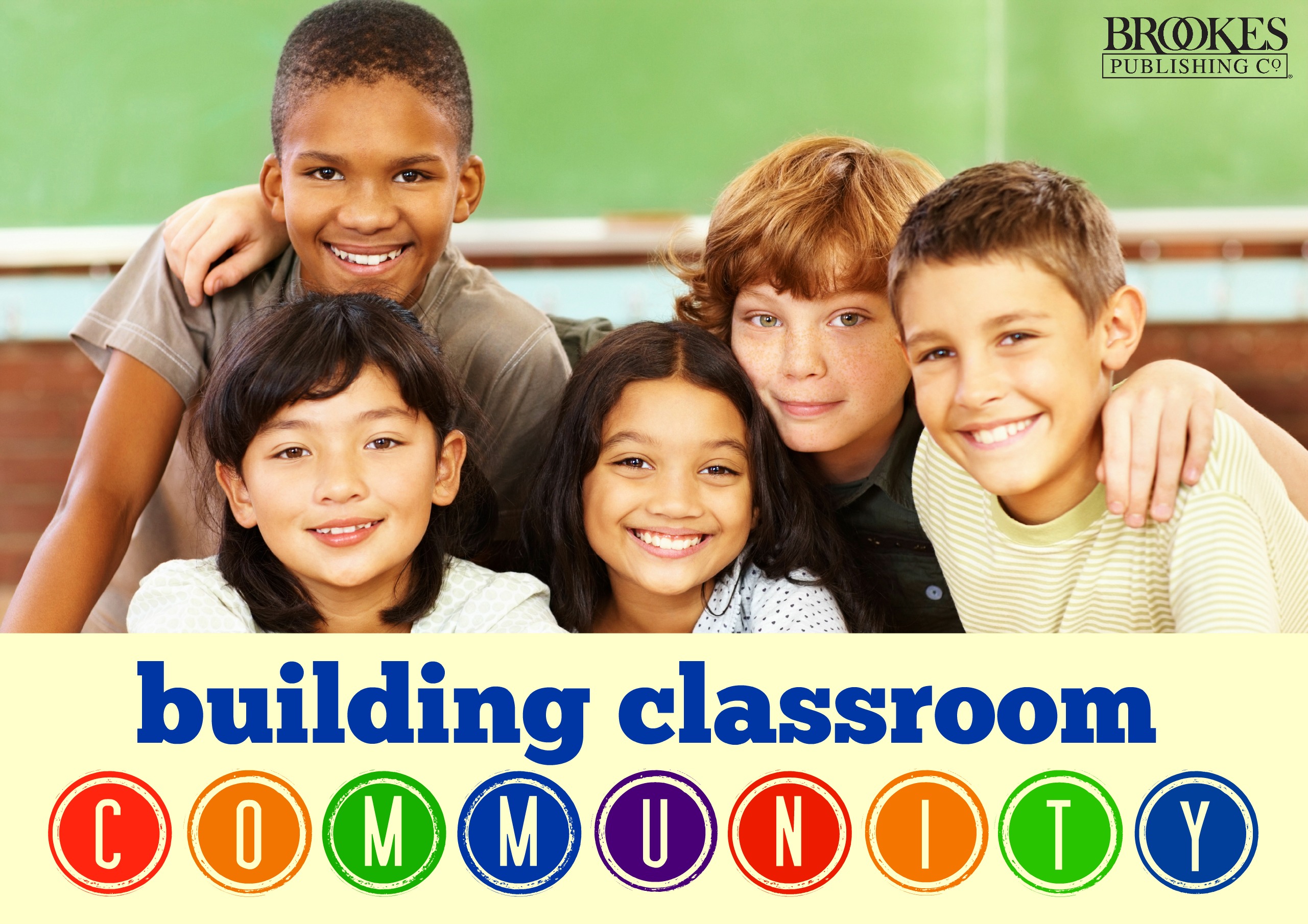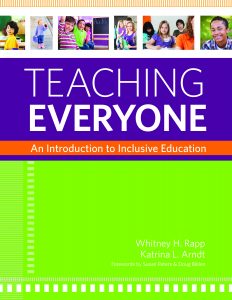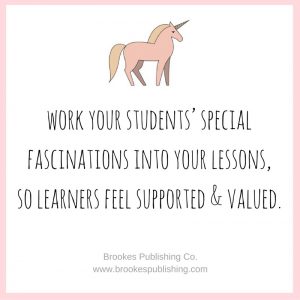9 Ways to Establish Community in Your Classroom
September 20, 2016
Every teacher wants to establish a classroom community where each child belongs and feels comfortable and welcome. That’s the kind of place where real learning happens–but a strong classroom community doesn’t spring up overnight or happen spontaneously. A real sense of community starts with your intentional guidance and support, and that’s what today’s post is all about.

Here are 9 practical things you can do this year to create a classroom community where every student belongs and learns. These are excerpted and adapted from Teaching Everyone, the wonderfully comprehensive guide to inclusive education by Whitney Rapp and Katrina Arndt. Try some of these in your classroom this fall–and let us know how it goes!
Create a welcoming physical space.
Take a good look at your classroom and the way it’s arranged. Does it provide your students with a welcoming environment? Does the configuration of furniture, equipment, and accessories help or hinder your teaching? Do all your students have a clear view of you, and can they move around freely without disturbing each other? Are there enough places for individual, small-, and large-group work? Take note of what’s working and not working and think about what changes you can make to better facilitate learning and classroom community.
Collaborate on class rules.
 All teachers know how important it is to establish rules and expectations during the first days of school. Requesting student input on the class rules can be a good way to foster collaboration and community. You might consider asking students which rules they think the class should have, so they can take part in a process grounded in shared decisions and democratic principles. Make it clear up front which issues you are vested in as a teacher (for example, emotional and physical safety for everyone), and remind students that you still must follow school and district rules. If you or the students don’t like a school or district rule, talk about it and consider investigating the reasons behind it.
All teachers know how important it is to establish rules and expectations during the first days of school. Requesting student input on the class rules can be a good way to foster collaboration and community. You might consider asking students which rules they think the class should have, so they can take part in a process grounded in shared decisions and democratic principles. Make it clear up front which issues you are vested in as a teacher (for example, emotional and physical safety for everyone), and remind students that you still must follow school and district rules. If you or the students don’t like a school or district rule, talk about it and consider investigating the reasons behind it.
Respect personal space.
Every student will need a different amount of personal space; addressing their different preferences and needs will go a long way toward making them feel comfortable and welcomed in the classroom. If some students need reminders to avoid moving into others’ personal space, provide clear visual boundaries such as tape on the floor around a desk or on the carpet. If a student needs extra personal space, they may ask to have a desk placed off to the side instead of in a group.
Play “Social Bingo.”
 Icebreakers that help your students get to know each other can be great community builders. Try this: Make a 5×5 grid on a piece of paper, one for each student. Type an interesting fact in each box on the grid–for example, has more than three siblings, likes pickles and peanut butter sandwiches, has slept in a tent, knows how to knit, or has a pet lizard. Include a blank signature line under each fact, and leave the grid’s center square blank with a line for the student’s name. When you pass the papers out, ask each student to sign his or her own paper in the center square and then get up and mingle, trying to get a signature from each classmate in a box that describes them. (Only include facts your students would be comfortable disclosing, and be careful not to highlight income disparities with facts like has been to Europe.)
Icebreakers that help your students get to know each other can be great community builders. Try this: Make a 5×5 grid on a piece of paper, one for each student. Type an interesting fact in each box on the grid–for example, has more than three siblings, likes pickles and peanut butter sandwiches, has slept in a tent, knows how to knit, or has a pet lizard. Include a blank signature line under each fact, and leave the grid’s center square blank with a line for the student’s name. When you pass the papers out, ask each student to sign his or her own paper in the center square and then get up and mingle, trying to get a signature from each classmate in a box that describes them. (Only include facts your students would be comfortable disclosing, and be careful not to highlight income disparities with facts like has been to Europe.)
Put together a class puzzle.
Cut a piece of posterboard into 6-inch puzzle pieces, one for each learner in your class. Ask each student to draw or write personal information on their square, such as name, age, and family members. If your students are young, they might report on how many teeth they have lost; older students might include a favorite song, book, movie, or future aspirations. If a new student enters your class, redo the class puzzle–it’ll give students a chance to update their information and share who they are with the new student, and it’ll help the new student join the community and feel valued.
Adapt lighting.
 Something as seemingly simple as lighting can have a big impact on whether your students feel comfortable and ready to learn. Many kids prefer natural lighting from windows, and some concentrate better with dimmer or softer lighting. To switch up your classroom lighting, you might use classroom light filters that come in assorted colors–or switch off your overheads and bring in a variety of lamps with soft or bright light bulbs to meet the needs of different students. You can also adapt your existing lighting by requesting that fluorescent bulbs be shielded or used at a low setting.
Something as seemingly simple as lighting can have a big impact on whether your students feel comfortable and ready to learn. Many kids prefer natural lighting from windows, and some concentrate better with dimmer or softer lighting. To switch up your classroom lighting, you might use classroom light filters that come in assorted colors–or switch off your overheads and bring in a variety of lamps with soft or bright light bulbs to meet the needs of different students. You can also adapt your existing lighting by requesting that fluorescent bulbs be shielded or used at a low setting.
Offer adaptations for sound sensitivities.
Your students will also vary in the amount of noise they like and can tolerate while working. Some like soft music, while others need absolute silence to work. Be aware of students who are sensitive to sound and provide strategies and simple adaptations to help them stay focused on their work. You might suggest that some students wear earmuffs or earplugs at times when noise is particularly distracting to them: for example, during Drop Everything and Read time or independent work.
Incorporate interests.
 When your students have strong interests and fascinations, you can see their passions in two ways: as a distraction from work or as an entry point to it. If your student loves unicorns and talks about them constantly, you might be tempted to ask her to cut down on the unicorn talk during class. But not letting kids talk about what they like isn’t the best way to build a strong classroom community. Instead, work your students’ special fascinations into your lessons, so learners feel supported and valued and are ready to do their best work. (Wondering how to do this? The book Just Give Him the Whale is packed with practical suggestions on using your students’ fascinations as invaluable learning tools.)
When your students have strong interests and fascinations, you can see their passions in two ways: as a distraction from work or as an entry point to it. If your student loves unicorns and talks about them constantly, you might be tempted to ask her to cut down on the unicorn talk during class. But not letting kids talk about what they like isn’t the best way to build a strong classroom community. Instead, work your students’ special fascinations into your lessons, so learners feel supported and valued and are ready to do their best work. (Wondering how to do this? The book Just Give Him the Whale is packed with practical suggestions on using your students’ fascinations as invaluable learning tools.)
Hold class meetings.
Brief morning check-ins with the whole class, for example, can help everyone feel welcomed and heard. They’re a good forum for students to report something new or good, air conflicts, and resolve problems. Sustain your strong classroom community by holding class meetings throughout the school year. As the year progresses, you can expand the purpose of the meetings–you can introduce new conversation prompts or give the whole class mini-lessons on a range of topics, from conflict resolution to asking for help.
These are just a few ideas to get you started on building a stronger classroom community. What are your favorite community-building ideas? If you have a strategy that’s worked well in your inclusive classroom, tell us in the comments below!

For more tips on supporting every learner in your inclusive classroom, read the other posts in our Fair Is Not Always Equal…Now What? blog series.
Check out Teaching Everyone by Whitney Rapp and Katrina Arndt, the book that gets you ready to see past disability labels and work with all children’s individual needs and strengths. It covers an amazing range of topics and includes teaching strategies for all major academic content areas!




Write a Comment
Your email address will not be published. Required fields are marked *
Post a Comment